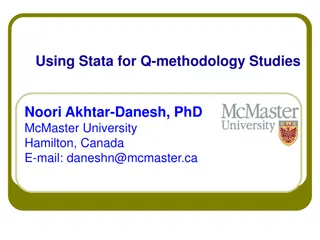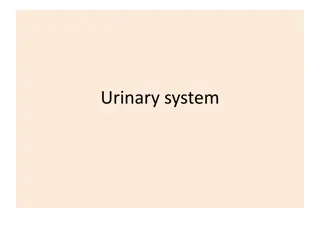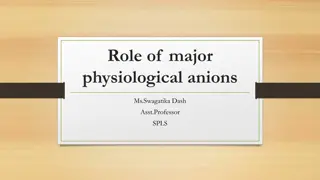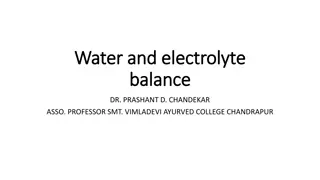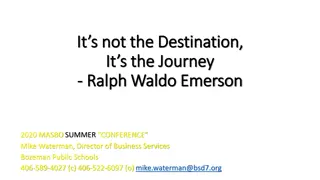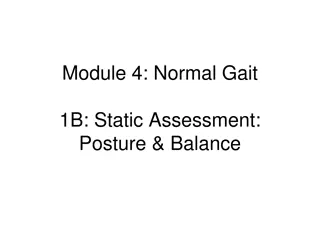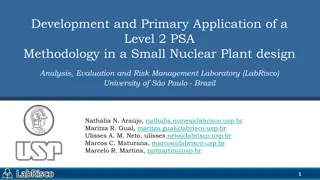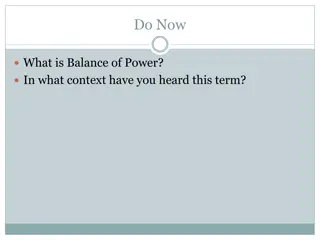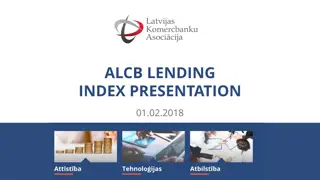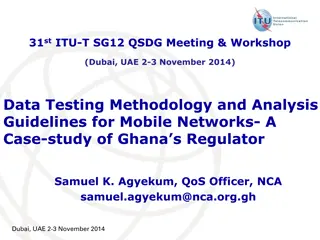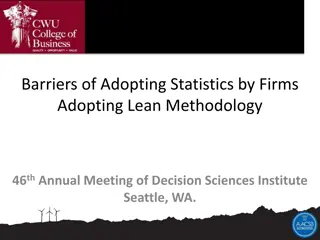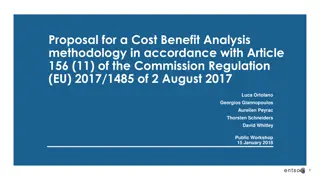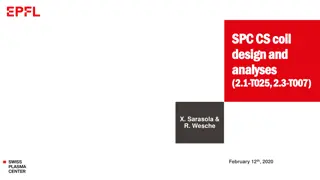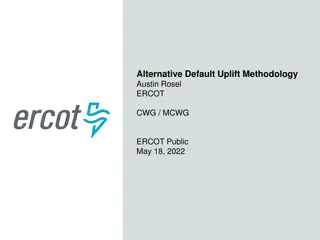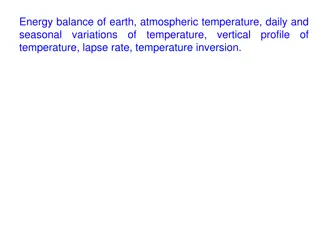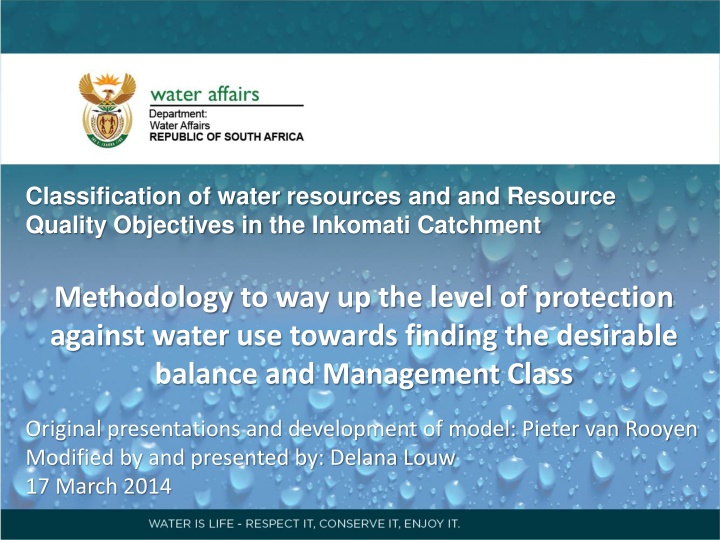
Balancing Water Resource Use and Protection in Inkomati Catchment
The methodology presented by Pieter van Rooyen and Delana Louw in 2014 focuses on classifying water resources and setting Resource Quality Objectives in the Inkomati Catchment. The process involves delineating units of analysis, engaging stakeholders, quantifying Ecosystem Water Requirements, evaluating scenarios within Integrated Water Resource Management, drafting Management Classes, and setting Resource Quality Objectives. The goal is to find a balance between ecological health and socio-economic considerations, ultimately leading to optimized scenarios that strike an acceptable equilibrium.
Download Presentation

Please find below an Image/Link to download the presentation.
The content on the website is provided AS IS for your information and personal use only. It may not be sold, licensed, or shared on other websites without obtaining consent from the author. If you encounter any issues during the download, it is possible that the publisher has removed the file from their server.
You are allowed to download the files provided on this website for personal or commercial use, subject to the condition that they are used lawfully. All files are the property of their respective owners.
The content on the website is provided AS IS for your information and personal use only. It may not be sold, licensed, or shared on other websites without obtaining consent from the author.
E N D
Presentation Transcript
Classification of water resources and and Resource Quality Objectives in the Inkomati Catchment Methodology to way up the level of protection against water use towards finding the desirable balance and Management Class Original presentations and development of model: Pieter van Rooyen Modified by and presented by: Delana Louw 17 March 2014
NWRCS integrated steps 1: Delineate units of analysis and describe the status quo 2: Initiation of stakeholder process and catchment visioning 3: Quantify EWRs and changes in Ecosystem Services 4: Identification and evaluation of scenarios within IWRM 5: Draft Management Classes 6: Resource Quality Objectives (EcoSpecs & water quality (user)) 7: Gazette class configuration Evaluating scenarios and determining MC 2
NWRCS integrated steps 1. Status quo, IUA delineation PSC 1 3. Quantify EWRs & links to EGSA THIS PSC 2 MEETING 4. ID Scenarios 4. Recommend Scenario & MC PSC 3 6. RQO
Step 4 and 5: IWRM & MCs NWRCS facilitates finding a balance between protection and use of the water resource. This process takes place during Step 4 and 5. This study is now at the start of this process. What needs to be balanced? Degree of the ecological health / status and socio-economics (Ecosystem services & Economic implications)
Step 4 and 5: IWRM & MCs The process of finding a balance is facilitated by assessing different future levels of water resource use. Different levels of water resource use are assessed by means of evaluating a range of possible future scenarios and determining the consequences of these scenarios on users and the environment. Aim is to design an optimised scenario that would result in an acceptable balance. Scenario links to MC and Catchment Configuration
Catchment Analysis Catchment Resource Availability Socio-Economic Water Requirements Ecological Water Requirements Use Protection Management Class (Decision) 6
What are scenarios? Scenarios, in context of water resource management and planning are plausible definitions (settings) of all the factors (variables) that influence the water balance and water quality in a catchment and the system as a whole (System s context) Different levels of water use and protection are evaluated with the aim to find a preferred scenario NWRC is the process to evaluate and recommend what that scenario entails
Scenario evaluation and MC Challenges: Integration Node / reach / river to catchment scale Ecosystem status/health (non-monetary) versus Socio-economics (non-monetary and monetary Management Class decision suport system or tool based on multi-criteria decision analysis approaches have been developed. The scenario evaluation process and integration fits within this approach. 8
Integrated Assessment of Scenarios Elements Variables Water Resource System Ecological health Integrated Units of Analysis Ecosystem Services River Reaches (Resource Unit) Economic Implications Biophysical Nodes Scenario Assessment
Scenario Evaluation Process Scenario Description Formulate Alternative Scenarios Select relevant scenarios Evaluate against vision Ecological Ecosystem Services Economics Non-Ecological Water Quality Stakeholder Evaluation Compare, rank & optimise scenarios Water Availability Analysis Information feeding into the process Evaluation and analysis steps Estimate consequences Scenario steps
Multi-criteria assessment For IUA / system method For all scenarios For each reach / node Geomorphology Integrated Comparison (all variables) Relative importance Physico-chemical Fish Weighting process Score Macroinvertebrates Riparian vegetation Consequences Degree of meeting REC ECOLOGICAL STATE Prevailing situation Culture Regulating Food, Fuel Weighting process Score Riparian vegetation Relative to present provisions ECOSYSTEM SERVICES Makeup of economy Jobs GDP Weighting process Score Consequences ECONOMY Relative to base condition
Scenario Comparison Visualisation Ecological Status relative to REC Economic Indicator Ecosystem Services Overall Ranking (Rank Order) Employment 5 10 REC 910 PES PES REC 6 10 9 PES 5 9 6 5 REC 6 1 2 3 4 5 6 1.0 2.0 3.0 1.0 2.0 3.0 1.0 2.0 3.0 1.0 2.0 0.25 3.0 1.0 2.0 3.0 0.5 0.05 0.2
Deriving the Management Class Scenarios and Management Class PES REC 1 II II III III III III III II III II II III I I I IUA 2 III III III III I 3 III III III III I 4 III III III III I 1 2 3 4 5
Scenario Comparison Visualisation Focus of the rest of the balance methodology presentation is to show how each of the variables come up with the individual ranking order and scoring PRIOR to integration Note, the catchment used is COMPLETELY HYPOTHETICAL and representative of a typical catchment. The results also this is just a demonstration and is intended to prepare you for providing input when the scenario evaluation is complete. Only aspect of this process undertaken during THIS PSC meeting is the input on the scenarios to be evaluated.

